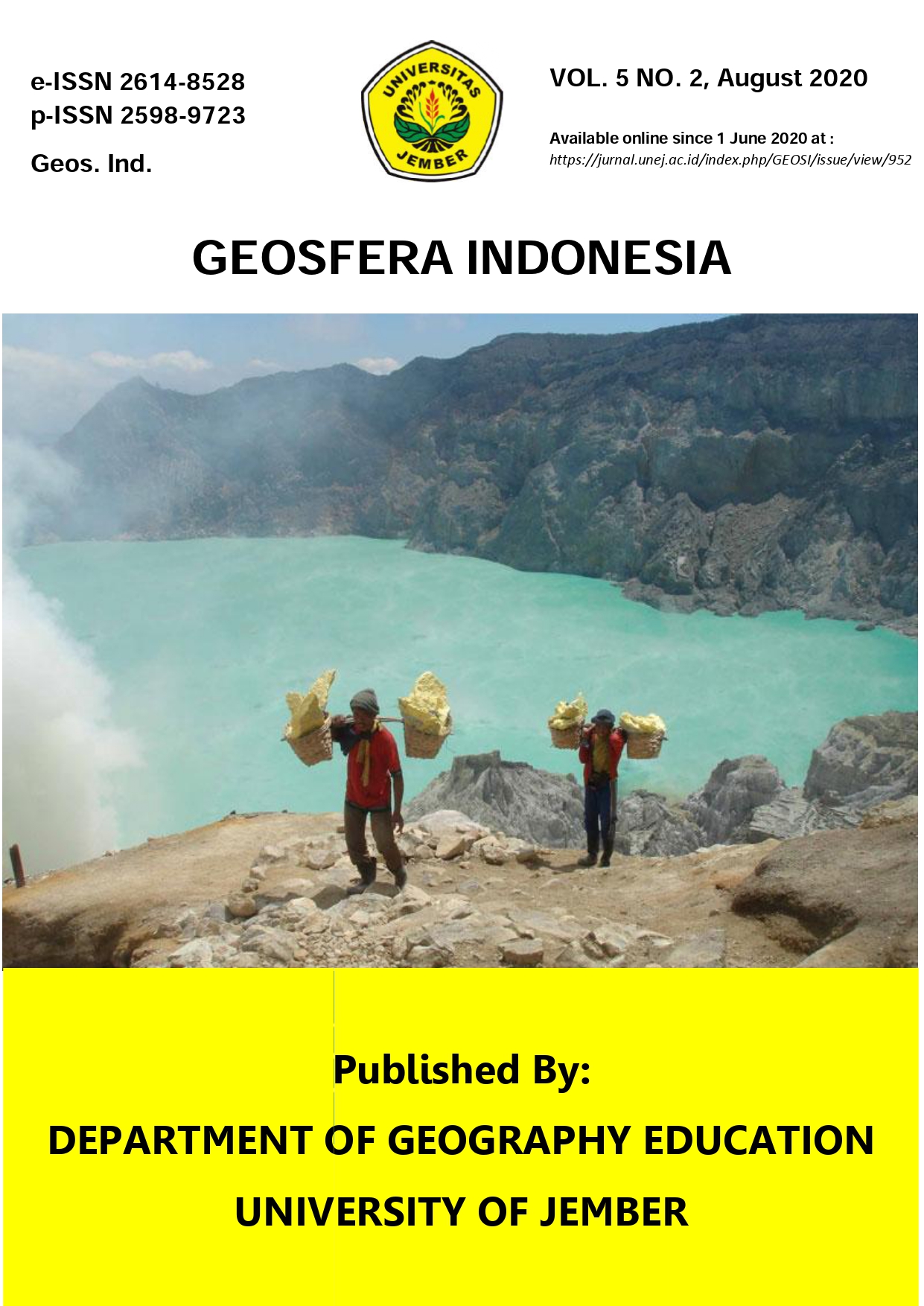A New Algorithm For The Grid Cell-Based Runoff Routing Model Based on Travel Time Concept
DOI:
https://doi.org/10.19184/geosi.v5i2.17351Abstract
The grid cell-based routing model has recently been used to simulate direct runoff hydrographs at catchment scales. This study develops a flexible event-based runoff routing algorithm to simulate a direct runoff hydrograph (DRH). The experiment was based on the spatiotemporal inputs of a hydrological data set. The flexibility is based on the time step and grid cell size applied in the original STORE-DHM. Rainfall distribution was obtained using radar data adjusted by the measured point ground, while the runoff yield was determined using the NRCS-CN method. The parameter distribution was captured in the GIS environment as raster data formats. Furthermore, it was converted into ASCII data formats for scripting the routing algorithm using Matlab programming codes. The model algorithm was tested for storm events within two small study river systems in Yogyakarta, Indonesia. One event in each catchment was selected and calibrated to the observed hydrograph, treating the Curve Number (CN) and Manning coefficient (n) values as parameter calibrations. In the end, two events were selected for validation. The proposed routing model algorithm simulates DRHs of all selected events in the study areas with excellent performance. The Nash-Sutcliffe coefficient was greater than 0.75 for all DRH during validation, and the volume bias and peak discharge error were less than 25%.
Keywords: Algorithm; Cell-based runoff routing; Travel time; GIS; Direct runoff hydrograph.
Copyright (c) 2020 Geosfera Indonesia Journal and Department of Geography Education, University of Jember

This work is licensed under a Creative Commons Attribution-Share A like 4.0 International License
Downloads
References
Al-Juaidi, A. E. M. (2018). A simplified GIS-based SCS-CN method for the assessment of land-use change on runoff. Arabian Journal of Geosciences, 11(269). https://doi.org/10.1007/s12517-018-3621-4
Asfaw, A., Maher, K., & Shucksmith, J. D. (2018). Modelling of metaldehyde concentrations in surface waters : A travel time based approach. Journal of Hydrology, 562, 397–410. https://doi.org/10.1016/j.jhydrol.2018.04.074.
Bansode, A. ., & Patil, K. A. (2014). Estimation of runoff by using SCS curve number method and arc GIS. International Journal of Scientific & Engineering Research, 5(7), 1283–1287.
Beven, K. (2012). Rainfall-Runoff Modelling: The Primer (2nd ed.). Chichester, UK: John Wiley & Sons, Ltd.
Chow, V. T., Maidment, D. R., & Mays, L. R. (1988). Applied Hydrology. Singapore: McGRaw-Hill Book Co.
Du, J., Xie, H., Hu, Y., Xu, Y., & Xu, C. Y. (2009). Development and testing of a new storm runoff routing approach based on time variant spatially distributed travel time method. Journal of Hydrology, 369(1–2), 44–54. https://doi.org/10.1016/j.jhydrol.2009.02.033.
Gonzalez, A., Temimi, M., & Khanbilvardi, R. (2015). Adjustment to the curve number (NRCS-CN) to account for the vegetation effect on hydrological processes. Hydrological Sciences Journal, 60(4), 591–605. https://doi.org/10.1080/02626667.2014.898119.
Kang, K., & Merwade, V. (2011). Development and application of a storage-release based distributed hydrologic model using GIS. Journal of Hydrology, 403(1–2), 1–13. https://doi.org/10.1016/j.jhydrol.2011.03.048
Maina, C. W., & Raude, J. M. (2016). Assessing Land Suitability for Rainwater Harvesting Using Geospatial Techniques : A Case Study of Njoro Catchment, Kenya. Applied and Environmental Soil Science, 2016. https://doi.org/dx.doi.org/10.1155/2016/4676435.
McCuen, R. H. (1998). Hydrologic Analysis and Design (2nd ed.). New Jersey: Prentice-Hall.
Melesse, A. M. (2002). Spatially distributed storm runoff modeling using remote sensing and geographic information system. The University of Florida.
Melesse, A. M., & Graham, W. D. (2004). Storm Runoff Prediction Based on a Spatially Distributed Travel Time Method Utilizing Remote Sensing and GIS. Journal of the American Water Resources Association, 40(4), 863–879.
Ponce, V. M., & Hawkins, R. H. (1996). Runoff Curve Number: Has It Reached Maturity? Journal of Hydrologic Engineering, 1(1), 11–19.
Rawat, K. S., & Singh, S. K. (2017). Estimation of Surface Runoff from Semi-arid Ungauged Agricultural Watershed Using SCS-CN Method and Earth Observation Data Sets. Water Conserv Sci Eng, 1, 233–247. https://doi.org/10.1007/s41101-017-0016-4.
Rohman, A., Comber, A., & Mitchell, G. (2019). Evaluation of Natural Flood Management using Curve Number in the Ciliwung Basin, West Java. In P. Kyriakidis, D. Hadjimitsis, D. Skarlatos, & A. Mansourian (Eds.), Geospatial Technologies for Local and Regional Development : Proceedings of the 22nd AGILE Conference on Geographic Information Science (Vol. 2018, pp. 2–5). Cham, Switzerland: Springer.
Satheeshkumar, S. Venkateswaran, S., & Kannan, R. (2017). Rainfall-runoff estimation using SCS–CN and GIS approach in the Pappiredipatti watershed of the Vaniyar sub-basin, South India. Model. Earth Syst. Environ., 3(24). https://doi.org/doi.org/10.1007/s40808-017-0301-4.
Singh, V. P., & Aravamuthan, V. (1996). Errors of kinematic-wave and diffusion-wave approximations for steady-state overland flows. Catena, 27, 209–227.
Singh, V. P., & Woolhiser, D. A. (2002). Mathematical Modeling of Watershed Hydrology. Journal of Hydrologic Engineering, 7, 270–292.
Soulis, X., & Valiantzas, J. D. (2012). SCS-CN parameter determination using rainfall-runoff data in heterogeneous watersheds – the two-CN system approach. Hydrology and Earth System Sciences, 16, 1001–1015. https://doi.org/10.5194/hess-16-1001-2012.
Tarboton, D. G., Schreuders, K. A. T., Watson, D. W., & Baker, M. E. (2009). Generalized terrain-based flow analysis of digital elevation models. 18th World IMACS/MODSIM Congress. Retrieved from http://mssanz.org.au/modsim09.
USDA. (2004a). Estimation of Direct Runoff from Storm Rainfall. In the National Engineering Handbook, Part 630: Hydrology.
USDA. (2004b). Hydrologic Soil-Cover Complexes. In the National Engineering Handbook, Part 630: Hydrology.
Vojtek, M., & Vojteková, J. (2016). GIS-Based Approach To Estimate Surface Runoff In Small Catchments : A Case Study. Quaestiones Geographicae, 35(3), 97–116. https://doi.org/doi:10.1515/quageo–2016–0030.
Zhao, L., & Wu, F. (2015). Simulation of Runoff Hydrograph on Soil Surfaces with Different Microtopography Using a Travel Time Method at the Plot Scale. PLoS ONE, 10(6), 1–14. https://doi.org/10.1371/journal.pone.0130794.



